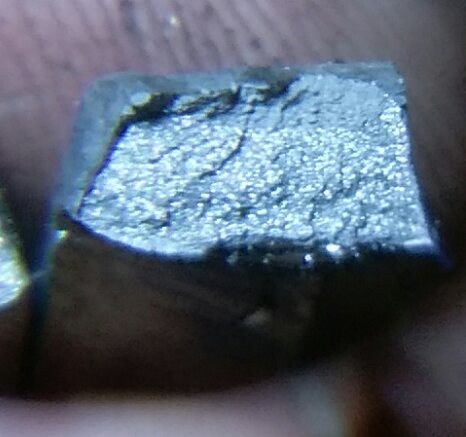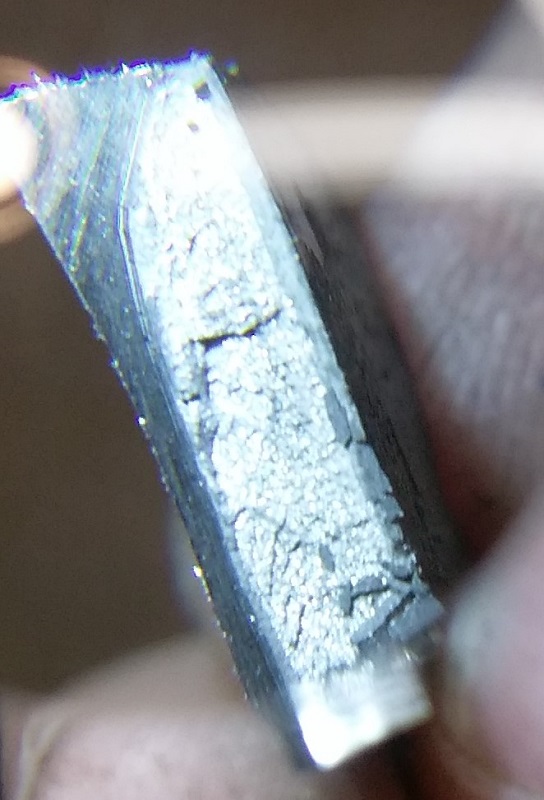I was told I could put silica sand in a container and bury my 1084 steel in it, then temper for 3 hours at 400 degrees to allow the sand to heat and temper the blade evenly. It sounds reasonable, but I have not seen this anywhere else. How accurate is this and how necessary is it to provide an even heat?
I am currently laying my knives on a roast rack on a cookie tray - 4oo degrees x 3 to air cool. And also the idea of water cooling at the end of each 2 hours.
I have read and like the idea of the $25 degrees for 2 hours twice, but am not sure if I should be using a substance to put the steel in, or if its fine o the rack.
Heat is heat....as long as it's even and consistent. Personally, I think that using a mass of sand large enough for a blade is only going to require extra time for the sand to reach temp. I'm sure there's some merit in it....but are the benefits worth the extra time it would take for the sand to heat up? That's a question that each individual must answer for themselves.
Personally, I temper with blades directly on the oven rack.
If you intend to test for JS and/or MS down the road, tempering temps/time are something you'll need to experiment with. You didn't mention the steel type you're using in reference to your tempering. Very important here.... tempering temps are not only dependent on steel type, but also the geometry you put on that/those blade(s).
Ed Caffrey, ABS MS
"The Montana Bladesmith"
www.CaffreyKnives.net
lost the reply I typed.
Im doing 1084 steel. I have W2, bar but will hold off on that for now.
my Knife is 1/4 thick 6 in blade (1 3/4 widest), 1/2 ricasso, 5 inch hidden tang
3 hour long tempering cycles at 400 degrees on rack with cold water form sink tap between cycles
thank you for your time in shedding light. I intend on breaking off a part of tang when finished for grain structure inspection and to see if I have avoided burning.
Depending on the type of blade grind/geometry you apply, I think you're in the ballpark with 1084. Personally, for the type of grind/edge that I use, I go 415F or 2 hours. Personally, the only part of your process that concerns me is cooling blade with cold water between cycles. I experimented with that, and even had a few blades tested to see what was happening. The results of water cooling between tempering cycles were some embrittlement within the steel versus allowing the blades to air cool between cycles.
What really caused me to take note of rapid cooling between tempering cycles was a failure with an individual who came to my shop to test for his JS..... everything looked good (with his test blade), he cut the rope just fine, but his edge chipped in several spot during the chopping portion of the test (that's a failure). He wanted to do the bend portion, just because, so we did. The blade broke at about 60-70 degrees of bend.
Afterward I asked him to walk me through his entire procedure with that blade...step by step. It seemed he had done everything correctly, but when we got to the tempering, he told me the temp he used, then he said he had cooled the blade in water between tempering cycles... obviously I can't say for sure if that was the exact cause of the blade breaking, but between that, and the testing that I had done, it was certainly a "smoking gun" in my opinion. Having said that, its not something I do, or would do with my blades.... but that's me. The best thing you can do is test the results of the method(s) you use, and if they work, then keep on using them. In my opinion the biggest differences in methods from Bladesmith to Bladesmith is the variables in each of our shops/processes. If we could eliminate ALL variables, then one method would work for everyone....but in reality, that's never going to happen. So the best we can do is experiment and figure out what gives each of us the results we seek.
One other thing in your reply caught my attention:
I intend on breaking off a part of tang when finished for grain structure inspection and to see if I have avoided burning
You said "breaking off" a part of the tang....does that mean that you heat treated the tang? I ask because I never heat treat the tangs.... for me it creates more problems then it solves. Also, in general, breaking/looking at the end of a tang is not a true picture of what's going on the actual cutting section of a blade. In the forging process, the end of a tang, because of it's usual cross section, is generally overheated/underheated, and will not provide a good indicator. What's really necessary is to wreck a few blades (finished ones) to get a decent idea of how your process is going. I know....not what you wanted to hear, but just like baking a cake....ya gotta break a few eggs! <img src=' http://www.americanbladesmith.com/ipboard/public/style_emoticons//smile.gi f' class='bbc_emoticon' alt=':)' />
Ed Caffrey, ABS MS
"The Montana Bladesmith"
www.CaffreyKnives.net
The cold water between tempers I got from this forum. I have not done so yet, an d if there is a chance at it being the wrong method, then Ill wait until i can develop consistent results before I start experimenting. You recommend 1 cycle of 415 degrees for 2 hours? or is that multiple 2 hours cycles?
honestly, im glad you see that tang part to test grain. It was a theory I had to see structure as I went along with out costing me the entire knife. Guess Im just gonna have to suck it up and break some. Right now, its taking me several hours to forge it out. Im sure once im down to a few hours it wont be as bad as I do feel it is critical for me to understand what kinda blade im producing.
On the tempering.... I do three, 2-hour cycles, allowing the blade to cool naturally to room temp between tempering cycles. Sorry to bring the bad news about the tang thing...but it will generally give you a "false" reading of just how well you're doing on a blade.
I'm not making a blanket statement about the water cooling between cycles, but it's not something I would do....that doesn't mean that others haven't been successful with it. That's the thing you'll come to understand over time... don't take anybody's word as "gospel" (including mine) until you prove or disprove it for yourself.<img src=' http://www.americanbladesmith.com/ipboard/public/style_emoticons//smile.gi f' class='bbc_emoticon' alt=':)' />
Ed Caffrey, ABS MS
"The Montana Bladesmith"
www.CaffreyKnives.net
Ill take your word as a master smith, and I will get better with my heat treats and tempers as a result of your sharing.
2 hour cycles at 415 degrees x3 it is. As for the tang, I will simple oversize to see whats going on inside when i profile the blade.
 this picuture is clip I cut off before normalizing to correct a cold shut forming because I was struggling to control fish lip.
this picuture is clip I cut off before normalizing to correct a cold shut forming because I was struggling to control fish lip.
 this is last part from end of tang after 2 normalizing phases and 3rd heat to vermiculite to anneal.
this is last part from end of tang after 2 normalizing phases and 3rd heat to vermiculite to anneal.
Still have issues to work out, like even heat, but this looks better than the grains I had been seeing, so I feel I am getting there. Knowing there is a problem is first step to fixing it...
That grain is pretty large. For lack of a better way to put it into words.... what I like to see is a smooth, velvety gray color, with no visible grains. It looks to me like you've had some overheating/over exposure going on in that blade.
Are you doing any thermal cycling after forging/before annealing?
Ed Caffrey, ABS MS
"The Montana Bladesmith"
www.CaffreyKnives.net
|quoted:
That grain is pretty large. For lack of a better way to put it into words.... what I like to see is a smooth, velvety gray color, with no visible grains. It looks to me like you've had some overheating/over exposure going on in that blade.
Are you doing any thermal cycling after forging/before annealing?
That is the end cut of tang after I normalized twice and cooled to hot to the touch but not burning. Third heat was just below curie point and put in vermiculite overnight. I haet treated last night and put in oven at 415 degrees for 2 hours, then when it had cooled all the way in the air, I put it in for another hour (was too late to do 2 hours). This morning at 6 AM I put it in for another 2 hours and wife took it out of oven an hour ago while im at work.
Its a new forge for me (blower style) so im trying to get used to it.
Oh yeah.....I know all about the "new forge" blues. <img src=' http://www.americanbladesmith.com/ipboard/public/style_emoticons//smile.gi f' class='bbc_emoticon' alt=':)' /> Once you get used to the forge, and get a bit more experience, start working on that grain structure..... it's just one of those things that takes a bit of time and experience.
Ed Caffrey, ABS MS
"The Montana Bladesmith"
www.CaffreyKnives.net
|quoted:
Oh yeah.....I know all about the "new forge" blues. <img src=' http://www.americanbladesmith.com/ipboard/public/style_emoticons//smile.gi f' class='bbc_emoticon' alt=':)' /> Once you get used to the forge, and get a bit more experience, start working on that grain structure..... it's just one of those things that takes a bit of time and experience.
appreciate it. Im not sure at what point im giving it the chance to get too hot and im sure as I watch for it, ill get faster and more efficient. Could very well be the excessive amount of heats I need to do for the tip and the bevels and as I get faster, it will spend far less time in forge. I prob have about 6 hours inside the forge re-heating and that could solve the mystery for me. I really feel better after these past few posts on my process and im sure Ill get this down soon enough!

